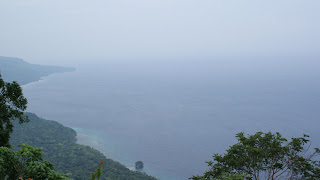The first thing Alofa and I did when we moved to the Kapiti Coast from Hamilton in March 2010 was to buy a whole pile of fish and chips and head to the beach.
Surrounded by the smell of the salt spray and a flock of noisy gulls, we surveyed the view, ate the fish and chips, and agreed that there was a natural harmony here between the things we could see and what we were eating. I’m not quite sure why, but even the very best fish and chips taste better when I’m at the beach. As soon as I’ve sat down on the sand and sprinkled on some vinegar a sense of familiarity and oneness creeps across my psyche.So, when we found out that I had been accepted to go on a two-year assignment with VSA in Timor-Leste I wondered if the fish and chips would taste as good sitting on the beach in Dili.
In order to get to Dili we had to fly to Brisbane. During the five hours we were stuck in the terminal I had a quick pie, knowing it would be the last pie I saw in a long while. Next it was on to Darwin for the night. In keeping with the “last meal” concept I decided to have a steak. We found the Victoria Hotel, not far from where we were staying, where I ordered a 16oz steak with mushrooms, fries and a side salad. The steak was a monster, and cooked to perfection (medium rare). The mushrooms were chunky sliced field mushrooms in a creamy brown sauce. I devoured the salad and the mushrooms disappeared quickly too. But while I tried valiantly with the steak, it was too much for me, and I had to leave a third of it on my plate. The next morning we flew into Dili. During our day-long orientation, I took a note of the warung (local eateries), that serve all sorts of Asian, Indonesian and even some Western food. That day we stopped at the City Café for lunch. It’s an “up-market” warung – it has air-conditioning – and while most of the vegetables we ate were new to me, they tasted great. The fried and/or steamed tofu, was excellent, too.
During the next few weeks we tried out other warungs. Most offer a smorgasbord of dishes. You point out your selections to the young girl behind the counter, who serves them and calculates the price – usually between US$2 to $3 for a healthy and substantial meal. Local specialities include nasi goreng and various soups. We also found excellent Thai restaurants and feasted on magnificent pizza at the Dili Club (which isn’t a club at all, but a restaurant and bar owned by a Kiwi).
But one thing I couldn’t find was a standard fish and chip shop. There was plenty of fish, but it all seemed to be roasted or served barbequed. I started to miss the familiar taste.Eventually we found a Singaporean supermarket that sold Frozen New Zealand “Dory Fish” – whatever that is – and organised a Friday night gathering of Kiwis for “fush and chups”. We battered the fish in tempura batter and deep fried it all in two large woks, one full of crispy fish, and the other deep fried potato chips. A little salt, vinegar, slice of lemon and tomato sauce and it was proclaimed to be a great success, but it didn’t feel quite right.
I realised that the problem was that I had not eaten it on the beach. I wondered whether such a thing would even be possible given the security issues in Dili, where there is no street lighting and little in the way of police patrols. How advisable would it be to be to sit on a beach eating food wrapped in paper in a country full of hungry people?My questions were answered a week later, when a friend invited us to “fish on a stick” after work on Friday. We headed down to Dili beach, where we found a collection of tents surrounded by a thick cloud of smoke coming from the many fires surrounding them. Cooking over the embers were skewers of sardines and mackerel, lined up neatly on their sticks like regiments of fish soldiers. There was also chicken satay, and Bar-B-Que chicken, Sausage on a stick, and even squid on a stick.
We soon learnt that the stalls are set up every evening and are run by local families who make their living providing this evening meal to everyone and anyone passing along the beach road, either as Take-away’s or to sit and enjoy the evening on the beach.We bought several skewers of fish, then grabbed a small woven basket of saffron rice, some home-made chilli sauce and a cold drink, and found a spot on under one of the tents to enjoy our meal.
The fish tasted smoky and magnificent. There weren’t any seagulls but there were dogs mooching around for scraps, and we could smell the sea. For the first time since arriving in Dili I felt that familiar harmony. It wasn’t fish and chips on the Kapiti Coast, but it was the Timor-Leste equivalent. 


















